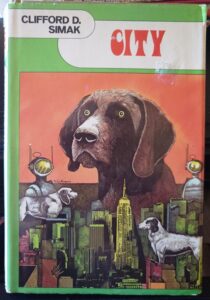My new novel, Neom, started off with the simple image of a robot and a rose. The robot goes to the market in the city of Neom and buys a flower. It then takes the rose into the desert and leaves it in the sand…
Why?
I wrote the rest of the book just to find out.
The truth is, I love robots. They are science fiction’s oldest, most reliable friends, though they have gone much out of fashion these days with their odd humanoid ways. Real robots build cars or fight wars. They don’t look like humans. Back in 2019 I visited a robotics lab in China and watched in fascination dragonfly robots and tapeworm robots and even a lobster robot. They didn’t look like people, though some are making androids even as we speak, and one, Sophia, was even granted Saudi citizenship in 2017. It’s a cool simulacra, though the rather unkind description of it as “a chatbot with a face” is not inaccurate. But still. Humanoid robots seem almost naïve, a piece of nostalgia from a long-vanished future.
Neom is set in a futuristic city on the coast of the Red Sea, a city dreamed up by a Saudi prince and marketed in the real world even as I type this, though it doesn’t yet exist. I thought it was a cool idea, though, and in my world it’s old, and filled with humans and robots, and the robots are old. Some of them did serve in the bad old wars and now haunt the desert. Others just try to get by. And since I love the history of science fiction, which is to say, the books I love to read, I put in a variety of robots, from a nod to the terrifying android in Alfred Bester’s “Fondly Fahrenheit” to the human-mimicking war robots of Philip K. Dick’s “Second Variety” to the stoic robots of Asimov and Simak.
Robots have been with us since Karel Čapek’s R.U.R. in 1921. They have kept us faithful company. It’s what they do. And they are still around. Here, then, are some of my favourite old and new stories about robots.

Second Variety by Philip K. Dick (1953)
As we go through Neom we find out that my robot (who is never named) had a group of companions during the long-ago war. One of them is, of course, a Tasso, from PKD’s classic story about a war in which humanoid robots infiltrate the human population only to blow themselves up. They come in several models, including the David (a young boy) and a Wounded Soldier, but there are rumours of a new, improved model…

City by Clifford Simak (1952)
If there is one specific type of robot I love above all else it’s the Simakian one. Stoic, patient, calm. Sometimes searching for God on a remote planet, as they did in Project Pope. Those robots gave rise to the Way of Robot religion featured in Central Station and a little in Neom, for in this extended universe there is indeed a Vatican of the Robot on Mars, and a Robo-Pope, who is even making an appearance in a small animated show I’ve recently finished making, called Mars Machines… But this is not about that.
Jenkins, the robot butler of the Webster family in the mosaic stories that make up Simak’s masterpiece, City, is probably my favourite. He is always there, always hoping for the best, for people to be better, even when there are no more people left and the dogs have taken over, only to learn to make weapons themselves… The talking jackal Anubis in Neom is of course a descendant of Simak’s dogs, while the recluses in the desert are called Websters – for reasons no one seems to remember anymore.

“Fandom for Robots” by Vina Jie-Min Prasad (2017)
From the old to the new, and I had the great pleasure to reprint Vina’s “Fandom For Robots” in my The Best of World SF: Volume 1 in 2021. An old obsolete machine discovers fandom and the power of stories, in this wonderfully funny and heart-warming peace.

“Twenty About Robots” by Alberto Chimal (2010), translated by Fionn Petch
I’m reprinting this in The Best of World SF: Volume 2, and it’s great fun – a series of twenty vignettes about robots from the weird mind of Alberto Chimal! I love stories that experiment with form and I just loved how he took something old and worn and made something new with it again.

“The Quest for Saint Aquin” by Anthony Boucher (1951)
A priest travels a post-apocalyptic world to find out if rumours of a saint whose body did not corrupt after death are true. He finds the saint, and the reason why the body is still in perfect form… It’s a lovely story and it touches on something that clearly interests me, which is the way robots and religion seem to intersect more often than we realise in science fiction.
Boucher, interestingly, was the first editor of The Magazine of Fantasy & Science Fiction, as well as a prolific mystery writer. His 1942 novel Rocket to the Morgue is a thinly-veiled roman a clef about the early SF scene in California, with characters based on Robert Heinlein and L. Ron Hubbard and others. I got interested in it since I have a long-delayed novel called The Circumference of the World coming out next year, and it touches on that period in the time of the field, looking as it does at the idea that a certain totally-made-up SF writer might have come up with his own religion – and what if he happened to accidentally be right?
“A Flaw in the Works” by Julie Novakova (2022)
Ok, I’m cheating a bit here – this is an original I’m publishing in The Best of World SF: Volume 2 (you should totally get it!), translated from Czech by the author. I don’t want to spoil it too much, but it’s a story that explicitly corresponds with Čapek’s R.U.R., a sort of alternate history with robots… And again shows how science fiction is always in conversation with itself, looking back just as we look forward.

“Fondly Fahrenheit” by Alfred Bester (1954)
The horrifying story about a man and his android travelling along the solar system… only, when it gets above a certain temperature the android starts killing people. I put a “Fondly” robot into Neom, because how could I not? One of Bester’s great stories.

“Act of Faith” by By Fadzlishah Johanabas (2010)
I love this story, which I reprinted in The Apex Book of World SF 3 in 2014. Can a robot be Muslim? the story asks, in what I always considered a sort of response to the Catholic Boucher’s story above. But the question of faith and machines goes to the core of science fiction, which asks what it means to be human within a vast cosmos. The robots are the mirrors we hold to ourselves as we seek meaning and understanding. The robots have been with us since we started writing about the future, and they accompany us still.
***


















